

"Much of what we know about objects from Viking Age comes from burials, for the pagan Norse buried people with all their personal possessions to use in the afterlife. Often these were royal or high status people who owned fine objects like you see in this chieftain's camp.
Norse traders used wide bodied ships to travel from Greenland in the West to Russia and even the Middle East. This merchant offers fine import goods for trade or purchase with silver coins. Both he and his wife display their wealth and position by their finely crafted and ornamented camp equipment and personal goods. Wealth can attract trouble, so 'A man should keep weapons close to hand'. "
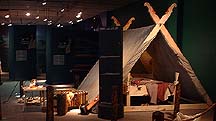
|
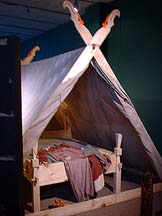 |
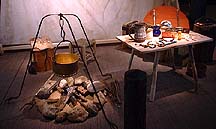
|
|
|
|
|
Many of the objects here are actually of 'Royal' quality, based on the ship burials of Oseberg and Gokstad. This is also camping equipment - remember that our Chieftain would own a large house complex as well.
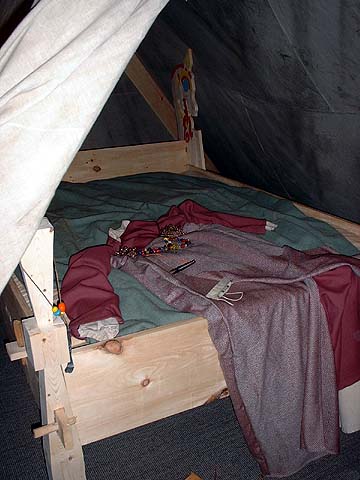
(1) 'High Status' woman's clothing:
We do not know the exact details of clothing, as almost no complete
garments survive. Reconstructions are based on depictions on sculpture
or jewelry. Cut of both men and woman's clothing was similar, the basic
T tunic. Social status (wealth) was determined by type of fibre, fineness
of weave, colour, embellishments. Compare with 'common man's' clothing
(Bondi).
Linen Underdress: Linen, from flax, was likely an import fabric.
Wool Gown : note longer length of underdress.
Wool Apron : There is much speculation on the exact cut of aprons
- and to their exact use. They could have been a cover worn while working
to protect the gown. They could have been a high quality garment worn over
working clothing. There actually could have been two different types, one
for each purpose. Use of a belt would have been required if worn working
around the fire!
(Conjecture wool, linen,
blends / artist : Vandy Simpson)
Leather Shoes : Note the similarity to First Nations' styles.
(Oseberg, Norway / 825 cow hide / artist :
David Cox)
Bronze Brooches : These 'Turtle Broaches' were especially common
in Iceland. They appear to have been heirloom objects, passed down through
the female line as sign of ancestry.
(Icelandic / Viking Age
cast bronze / artist : Ray Moseley
Artifact in Full Circle)
Bead Festoon : Bright glass beads are typically worn by women,
and appear a common favorite. Note amulets, shears. See also Trade Goods.
(Various / Viking Age
glass beads, pewter mounts, shears
Artifact in Full Circle)
Antler Comb : The Norse were actually very concerned about physical
appearance and cleanliness. Deer antler combs are a common artifact.
(York, England / 900's
red deer antler / artist : Dave Cox
Artifact in Full Circle)
Key : This is a mark of a woman's position, controlling the household
wealth. This key opens the padlock on the banded chest.
(Composite / Viking Age
forged steel)
(2) Bed : Based on sample from Gokstad. The sample from Oseberg
was about the size of a modern 'queen'. Only the very wealthy would own
individual furniture, most people slept on the wooden benches built into
the side walls of the long house.
(Oseberg & Gokstad, Sweden / 825
pine / artist : Brad Markewitz)
Mattress : Evidence from Oseberg suggests a feather mattress,
straw would have certainly been used as well.
(Conjecture
cotton, foam, styrofoam / artist : Vandy Simpson)
Wool Blanket : Down 'comforters' are another possibility. Sheep
skin or fur throws would have been used in the dead of winter. Compare
with the Bondi's sleeping bag.
(Conjecture
wool / artist : Vandy Simpson)
(3) Tent : Once again, a specially built tent is clearly an extremely
high priced item. When traveling, the wood beams would be stored on the
ship's oar rack. The cover could have been felted wool or leather (both
heavy) or linen canvas. The frame pegs together and does not need any ropes
to hold it to the ground - one person can set it up in about 5 minutes.
(Oseberg, Norway / 825
pine frame / artist : Brad Markewitz canvas cover)
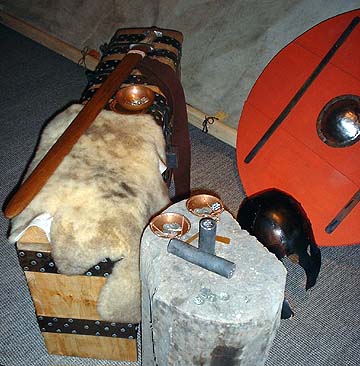
(4) Shield : There are few complete shields that survive, but
the central metal boss is commonly found. Although this version is pine,
shields were made of ash. Wooden shields would have been 'throw away',
and have to be replaced after each battle. Note the single central handle,
unlike the double arm strap used in the Middle Ages. Weight is about 8
- 10 lbs, this sample a bit small at 32".
(Gokstad, Norway / 800
pine, forged steel
Artifact in Full Circle)
Helmet with chain maile. Only about a dozen helmets have survived
from the Viking Age. NONE have horns - this is a Victorian artist's fiction.
Based on the sample from York, England, the original had elaborate cast
bronze pieces attached. Here a simple 'burned bee's wax finish has been
applied to protect the metal. Weight is about 5 1/2 lbs, about the same
as a modern military helmet. Compare with the simple helmet of the Bondi.
(York, England / 775
steel, felt / artist : Mark Planchet maile : Neil
Peterson)
(5) Silver Pennies : The Viking Age marks the beginning of widespread
use of silver coins as currency, replacing the barter system more common
earlier. Trade is becoming more international, fueled by huge extortion
payments from the English and carried on the Longship. Silver coins from
all over the trading world are found in Norse sites.
(Eric Bloodaxe York, England / 950
Hedeby Ship Blekinge, Sweden / 825
St Peter York, England / 920
Olaf Guthfrithsson York, England / 940
all sterling silver Artifact
in Full Circle)
Coin Dies : Individual coins are stamped from hand cut silver
disks, thus bearing the mark of the king who has commissioned their productions.
It was a mark of considerable importance to issue currency.
(York, England / 925
forged steel)
Scale with Weights : Coins were spent as silver weight
- not an abstract value as todays currency. 'Change' was made by cutting
up coins. Scales were used to determine weight.
(Various / Viking Age
copper sheet, cast pewter
Artifact in Full Circle)
(6) Sea Chest : This is a 'strong box', lockable and for storing
valuables. Note that it still could be carried off - security was against
casual theft only.
(Oseberg, Sweden / 825
pine, mild steel / assisted by Brad Markewitz)
Pad Lock : Refer to Key (#1)
(Composite / Viking Age forged steel)
Sword with Scabbard: Film and theater have made people think
swords are heavy. This sample is on the light end of the normal range of
2 - 3 lbs. Swords increase in length during the Viking Age from an average
of 32 -34" (like this one) to as much as 38". This is due to the influence
of horse mounted combat in Europe. This sword is fitted with a baldric
for carrying (which makes it easier to run!). Hilt is caribou antler, the
pommel is cast of pewter. A sword is an extremely expensive and specialized
tool, not every man owned one. Compare with spear in Bondi, axe in Town
House.
(Various / Viking Age
rehilted commercial blade, wood, leather
Artifact in Full Circle)
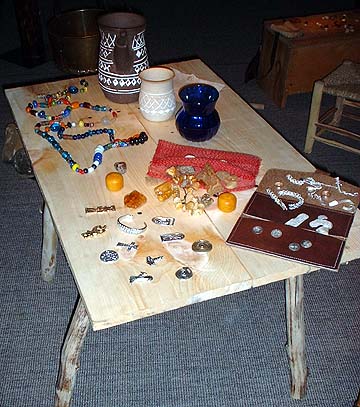
(7) Table : Only fragments of tables survive. It may be that
they were not at all common - or simply that broken tables became fire
wood.
(Conjecture
pine)
Ceramic Beaker and Jug : Based on samples found in Birka,
Sweden - but imports from the Rhineland in Germany. Ceramic was uncommon.
Soapstone cooking pots are widely found. This is because it is an easily
found raw material and can be worked by anyone with a knife. A potter needs
special equipment and skills to create ceramics.
(Birka, Sweden / 800's
stoneware / artist : David Clarke
Artifact in Full Circle)
Glass Beaker: At the top end of the status scale was imported
glassware from southern Europe. Difficult to make, fragile to transport.
Compare the various table ware in the three settings for materials and
status.
(Birka, Sweden / 800's
blown glass / artist : Mark Lewis)
Glass Cup : In the form of a drinking horn. Objects like this
were specially made for export to the 'Barbarian Market'. Clear glass,
free of bubbles, was difficult to achieve in the period.
(Birka, Sweden / 800's
blown glass / artist : Mark Lewis
Artifact in Full Circle)
Beads : Bright colours were highly prized. Beads were imported,
as well as glass chunks for local production in the new trade centres.
The spotted 'millifiori' (million flower) type were especially valued.
Spot the use of beads as decoration throughout the exhibit.
(Various / Viking Age
commercial glass
Artifact in Full Circle)
Amber : Trade has to follow in both directions. The ideal item
would be common in one area but rare in some other. It would be small and
light, valuable, and relatively rugged. Amber is washed up on beaches around
the Baltic Sea - and not available in the Mediterranean or Middle East.
Although like a stone, it is warm to the touch. Sometimes it contains insects.
All these factors made it seem magical - and an ideal Northern export.
It was made into smooth beads or carved into amulets.
(Various / Viking Age
natural / source : Amber World)
Woolen Pouch : Hand spun threads, hand woven to produce the cloth.
Refer to the Loom in Bondi.
(Conjecture
wool/ artist : Vandy Simpson)
Bronze and pewter Mounts: Simple cast mounts were used as decoration
on wood or leather, or worn as pendants. Spot similar mounts through the
exhibit.
Pewter was a mixture of lead and tin that was cast in stone molds.
When fresh made, it looked like silver without the cost! Likely the Norse
would have kept these items polished bright (unlike the practice today
were the lead is allowed to oxidize gray).
Bronze is a mixture of copper and tin, during the Viking Age scarcity
of materials resulting in both lead and zinc being added as well. Easy
to cast and quite durable, much jewelry in the period is made of this metal.
Compare with woman's Broaches.
Thor's Hammer : The Norse were not Christian at the start of
the Viking Age. Thor was the 'common man's' god, controlling weather. Hammers
are the single most common token found.
Serpent : In central England, coiled worn fossils were thought
to be petrified snakes, and finding one was considered good luck. The shape
is rendered in wood, antler, jet, and metal throughout England and Ireland.
This sample based on a wooden token found in Dublin Ireland.
Crosses: During the Viking Age, the Norse are exposed to and
slowly accepting of, Christianity. By the year 1000, the population would
have been split between the old and new faith. Those in the Scandinavian
homelands held on to their ancient beliefs the longest. Wise merchants
would cater to both customers!
Strap Mounts: the D shaped strap mounts were used to reinforce
tablet woven belts and decorate leather straps. One of the most commonly
found types of dress ornamentation, working in all range of materials.
(bracelet Ornum, Denmark / Viking Age
serpent Dublin, Ireland / 1000's
valkyrie Oland, Sweden / 900's
balance are original designs
tin or copper alloy
Artifact in Full Circle)
Leather Wallet containing Silver Pennies and 'Hack
Silver': This simple folded leather pouch was one way to carry your
wealth. Scraps of silver, wire, ingots, fragments of jewelry - all could
be weighed and 'spent'. Small piles of silver like this were often buried
by their owners for safety, but lost when that owner never returned.
(Various / Viking Age
silver - mixed fragments
Artifact in Full Circle)
Birch Bark Texts with runic inscriptions : Various evidence suggests
that use of the runes as a written language was relatively widespread,
not just for memorials but also for casual use. In Russia, simple texts
such as these were found written on strips of birch bark. These are shipping
labels. The first says - 'Sigmund owns this stack'. The second reads -
'Thorkjell the moneyer sends you pepper'.
('Sigmund' - Trondheim, Norway / Viking Age
'Thorkjell' - Bryggen, Norway / 1200
natural birch bark)
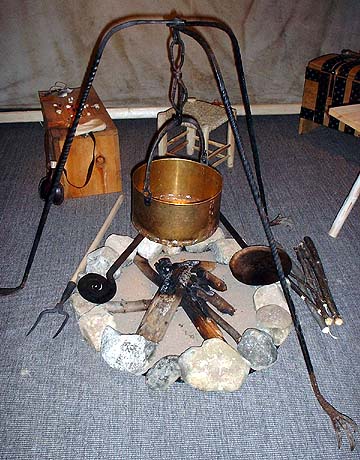
(8) Tripod : Again a royal quality item, from the Oseberg burial.
This tripod contains enough metal for three swords. It also does not work
correctly, as there is no way to raise or lower the pot for cooking temperature!
(Would a queen ever actually cook herself?) Compare with Bondi campfire.
(Oseberg, Norway / 825
forged steel)
Dish Iron : Bead ovens were rarely used. 'Bread' would have been
more like a flat pancake or cracker (flat breads are still popular in Scandinavia
today). This was a difficult object for the blacksmith to make. Wrought
iron is difficult to form to thin sheet with only the simple tools available
at the time. Link to Town House Blacksmith.
(Lekve, Norway / Viking Age
forged steel
Artifact in Full Circle)
Spiral Iron : For grilling meat. One solution to the metalworkers
problem producing sheet is to take a flat bar and coil it. This still uses
a lot of material (this strip was six feet long to start!). Link to Town
House Blacksmith.
(Berger, Norway / Viking Age
forged steel)
Bronze Pot : Sheet bronze pots like this one are thought to be
used to serve heated wine or mead - and thus are a high status item. Normal
cooking pots were formed of sheet iron. Compare with that in Bondi.
(Mastermyr, Sweden / 1150
brass, forged steel)

(9) Sea Chest : Small sea chests like this one would have held
all the possessions that the typical person owned. It would also have served
as a rowing bench on board ship. This one has carved game board for 'Hnefatafl'
(see below). Compare with other sea chests.
(Oseberg, Norway / 825
pine, leather / assisted by Brad Markewitz)
Game Pieces : For the game 'Hnefatafl', or King's Table. These
pieces combine found objects (stones, shells, antler) with glass beads.
Compare with Trencher game board in Bondi.
(Uppland, Sweden / 900's
glass, antler, found object, leather
Artifact in Full Circle)
Leather Bottle : How do you store liquids if glass is too expensive
to use for bottles? This leather bottle is a pouch shape stitched of two
pieces, wet and stretched, then dried and coated with wax. Compare with
other liquid storage (cooperage, gourd bottle).
(Conjecture
waxed leather / artist : David Cox)
Steel with Flint : Sparks struck off the steel with the
flint would be caught on tinder to start a fire. Certainly a skill to master.
Steels were often ornamental forgings, and would have been 'one per household'
rather than personal items. Flint and jasper strikers have given clues
to travel patterns.
(Uppland, Sweden / Viking Age
forged steel, natural flint
Artifact in Full Circle)
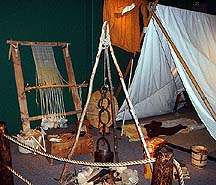
|
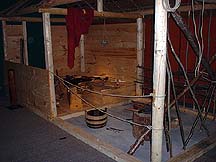
|
|
|
|